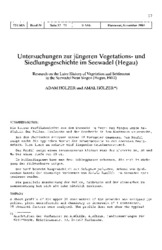Untersuchungen zur jüngeren Vegetations- und Siedlungsgeschichte im Seewadel (Hegau)
Hölzer, Adam
Hölzer, Amal
Hölzer, Adam; Hölzer, Amal, 1989: Untersuchungen zur jüngeren Vegetations- und Siedlungsgeschichte im Seewadel (Hegau). In: TELMA - Berichte der Deutschen Gesellschaft für Moor- und Torfkunde, Band 19: 57 - 75, DOI: 10.23689/fidgeo-3328.
 |
Dokument öffnen: |
Ein kurzer Profilabschnitt aus dem Seewadel im Hegau bei Singen wurde bezüglich der Pollen, Großreste und der Geochemie in 1cm-Abständen untersucht.
Bei den chemischen Analysen wurden 28 Parameter gemessen. Das Profil zeigt nicht die typischen Maxima der Schwermetalle in den obersten Zentimetern. Dies liegt am relativ tief liegenden Grundwasserstand.
Das Profil zeigt einen interessanten kleinen Peak der Elemente Sn, Ni und Mo bei einer Tiefe von 28 cm.
Im Pollendiagramm kann man drei Schlagphasen erkennen, die sich im Rückgang der Fichtenkurve zeigen.
Der Torf besteht hauptsächlich aus Sphagnum palustre. Anhand von Großresten konnte das ehemalige Vorkommen von Betula humilis im Seewadel nachgewiesen werden.
Die parallele Bearbeitung der Pollen, Großreste und der chemischen Zusammensetzung hat sich als sehr nützlich erwiesen. A short profile of the upper 31 centimeters of the Seewadel was analysed for pollen, plant macrofossils and chemistry in intervals of 1 centimeter. 28 chemical factors were analysed. The profile does not show the typical maxima of the heavy metals in the upper part. That is because of the low ground-water level. There exists an interesting peak of Sn, Ni and Mo. In the pollen diagramm one can notice three phases of tree-cutting by the decline of Picea.
The peat consists mainly of Sphagnum palustre. By seeds the existence of Betula humilis in the Seewadel could be proved in the past.
The combined analysis of pollen, macrofossils and chemistry proved very useful.

